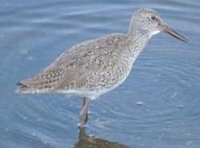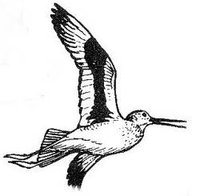Willet
|
|
| Willet Conservation status: Lower risk (lc) | ||||||||||||||
|---|---|---|---|---|---|---|---|---|---|---|---|---|---|---|
 Willet | ||||||||||||||
| Scientific classification | ||||||||||||||
| ||||||||||||||
| Binomial name | ||||||||||||||
| Catoptrophorus semipalmatus Gmelin, 1789 |
- Willet is a variant of the name William
The Willet, Catoptrophorus semipalmatus, is a large shorebird.
Adults have grey legs and a long straight dark bill. The body is dark grey on top and light underneath. The tail is white with a dark band at the end. The wings have a distinctive black and white pattern.
Their breeding habitat is salt marshes in eastern North America from Nova Scotia to the Gulf of Mexico and fresh water prairie marshes in western North America from southern Canada to the northern United States. They nest on the ground, usually in well-hidden locations in short grass, often in colonies.
They migrate to the Atlantic coast from North Carolina to northern South America in the west and to the Pacific coast from California to South America in the east.
These birds forage on mudflats or in shallow water, probing or picking up food by sight. They mainly eat insects, crustaceans and marine worms, but also eat some plant material.
At one time, this bird was hunted, but their population has recovered well.

